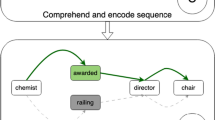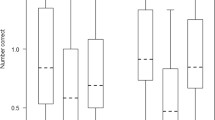Abstract
An experiment is reported concerning the role of working memory components in syllogistic reasoning. In this study, the syllogistic premises were presented sequentially and subjects attempted the syllogisms with and without three secondary tasks (articulatory suppression; spatial suppression and verbal random generation). Taking account of possible trade-offs among the dual tasks, it appeared that syllogisms with sequentially presented premises markedly loaded the central executive and the phonological loop components of working memory and also showed an involvement of the visuo-spatial scratchpad. It appears that the “slave” systems of working memory were more heavily loaded when sequential presentation of premises was used than was found previously with simultaneous premise presentation (Gilhooly, Logie, Wetherick & Wynn, 1993).
Similar content being viewed by others
References
Baddeley, A. (1986). Working memory. Oxford: Oxford University Press.
Baddeley, A. D. (1992) Is working memory working? Quarterly Journal of Experimental Psychology, 44A, 1–32.
Baddeley, A. D. & Hitch, G. J. (1974). Working memory. In G. Bower (Ed.), Recent advances in learning and motivation Vol. VIII, New York: Academic Press.
Begg, I., & Denny, J, P. (1969). Empirical reconciliation of atmosphere and conversion interpretations of syllogistic reasoning errors. Journal of Experimental Psychology, 81, 351–354.
Evans, F. J. (1978). Monitoring attention deployment by random number generation: an index to measure subjective randomness. Bulletin of the Psychonomic Society, 12,35–38.
Evans, J. St. B. T. & Brooks, P. G. (1981). Competing with reasoning: a test of the working memory hypothesis. Current Psychological Research, 1,139–147.
Evans, J. St. B. T., Newstead, S. E. & Byrne, R. (1994). Human reasoning: The psychology of deduction. Hove, East Sussex: Lawrence Erlbaum Associates.
Farmer, E. W., Berman, J. V. F. & Fletcher, Y. L. (1986). Evidence for a visuo-spatial scratch-pad in working memory. Quarterly Journal of Experimental Psychology, 38A, 675–688.
Fisher, D. L. (1981). A three-factor model of syllogistic reasoning: the study of isolable stages. Memory and Cognition, 9,496–514.
Ford, M. (1995). Two modes of mental representation and problem solution in syllogistic reasoning. Cognition, 54, 1–71.
Gilhooly, K. J., Logie, R. H., Wetherick, N. E. & Wynn, V. (1993). Working memory and strategies in syllogistic reasoning tasks. Memory and Cognition, 21, 115–124.
Halford, G. S., Bain, J. D. & Maybery, M. T. (1984). Does a concurrent memory load interfere with reasoning? Current Psychological Research and Reviews, 3,14–23.
Hitch, G. J. and Baddeley, A. D. (1976). Verbal reasoning and working memory. Quarterly Journal of Experimental Psychology, 28,603–621.
Johnson-Laird, P. N. (1983). Mental models. Cambridge: Cambridge University Press.
Johnson-Laird, P. N. & Bara, B. (1984). Syllogistic inference. Cognition, 16,1–62.
Johnson-Laird, P. N. & Byrne, R. (1991). Deduction. Hove: Lawrence Erlbaum Associates.
Logie, R. H. (1991). Visuo-spatial short term memory: visual working memory or visual buffer. In C. Cornoldi & M. McDaniel (Eds.) Imagery and cognition (pp. 77–102). Springer-Verlag.
Logie, R. H., Zucco, G. & Baddeley, A. D. (1990). Interference with visual short-term memory. Acta Psychologica, 75,55–74.
Norman, D. A. & Shallice, T. (1980). Attention to action. Willed and automatic control of behavior. University of California San Diego CHIP Report 99.
Polk, T. A. & Newell, A. (1995). Deduction as verbal reasoning. Psychological Review, 102, 533–566.
Schneider, W. (1990). MEL User's Guide: computer techniques for real time psychological experimentation. Pittsburgh, PA: Psychology Software Tools.
Stenning, K. & Oberlander, J. (1995). A cognitive theory of graphical and linguistic reasoning: Logic and implementation. Cognitive Science.
Sternberg, R. J. & Turner, M. E. (1981). Components of syllogistic reasoning. Acta Psychologica, 47,245–265.
Toms, M., Morris, N. & Ward, D. (1993). Working memory and conditional reasoning. Quarterly Journal of Experimental Psychology, 46A, 679–699.
Wetherick, N. E. & Gilhooly, KJ. (1995). “Atmosphere,” matching and logic in syllogistic reasoning. Current Psychology, 14, 169–178.
Wilkins, M. C. (1928). The effect of changed material on the ability to do formal syllogistic reasoning. Archives of Psychology, No. 102.
Woodworth, R. J. & Sells, S. B. (1935). An atmosphere effect in formal syllogistic reasoning. Journal of Experimental Psychology, 18,451–460.
Author information
Authors and Affiliations
Rights and permissions
About this article
Cite this article
Gilhooly, K.J., Logie, R.H. & Wynn, V.E. Syllogistic reasoning tasks and working memory: Evidence from sequential presentation of premises. Curr Psychol 21, 111–120 (2002). https://doi.org/10.1007/s12144-002-1007-x
Accepted:
Issue Date:
DOI: https://doi.org/10.1007/s12144-002-1007-x




